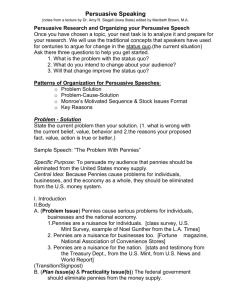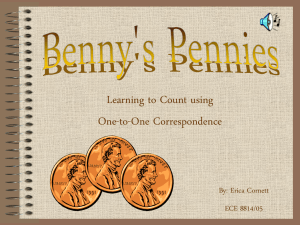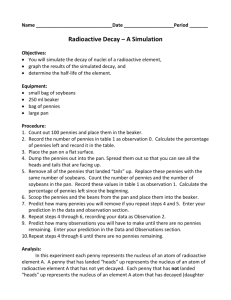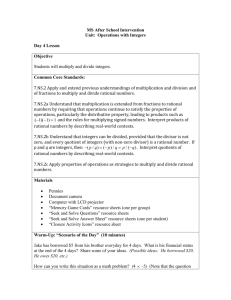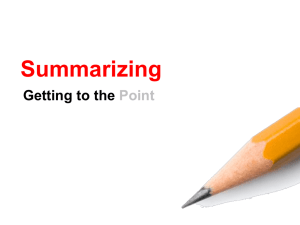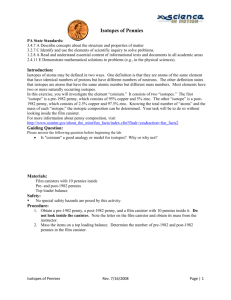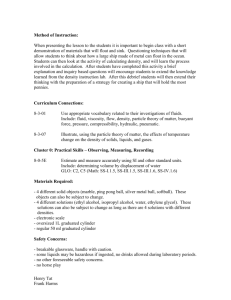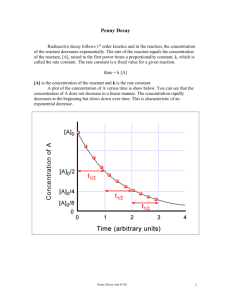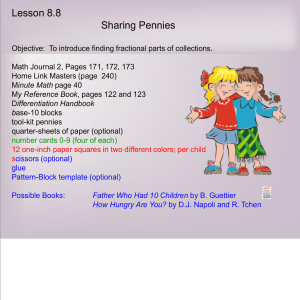problem
advertisement
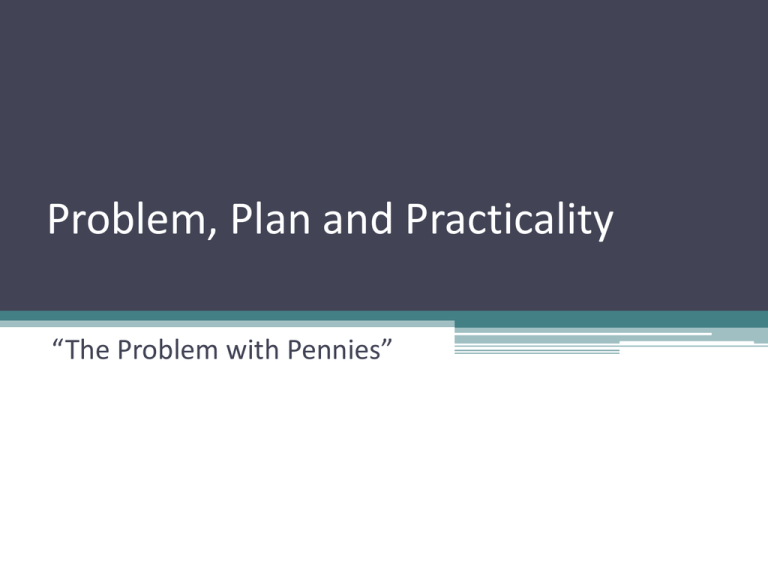
Problem, Plan and Practicality “The Problem with Pennies” Listen For the Following • What are the Problem issues in this speech? (Who is our present policy toward the Penny hurting?) • What is the Plan? • How does the speaker work to prove that the plan is Practical? (show it solves the problem, anticipates objections, provides evidence of ease) The Problem With Pennies By Susan Ingraham Pennies are Dead Problems for Individuals • 2/3 of class don’t like them • Only ½ of people surveyed use them daily • Pennies from heaven? Problems for Businesses • 5.5 million hours = $22 million cost • 30 cents for every $1 of pennies = expensive Problems for the Nation • 7 billion taken out of circulation/year • Billions more in jars and piggy banks • 6% of Americans throw them out • 12 billion new pennies = $80 million/year Solution From the Coin Coalition 1) Round off purchases to nearest nickel 2) Round off sales tax to nearest nickel 3) Stop making new pennies 4) Cash in pennies It Could Work! Remember the Half-Cent Coin? You Already Round Off! Learning groups discussion • What are the Problem issues in this speech? (Who is our present policy toward the Penny hurting?) • What is the Plan? • How does the speaker work to prove that the plan is Practical? (show it solves the problem, anticipates objections, provides evidence of ease) Problem Issue Development • Pennies are a nuisance for individuals. • EVIDENCE: class survey, U.S. Mint Survey, example of Noel Gunther from the L.A. Times Problem Issue Development • Pennies are a nuisance for businesses. • EVIDENCE: Fortune magazine, National Association of Convenience Stores Problem Issue Development • Pennies are a nuisance for the nation. • EVIDENCE: stats and testimony from the Treasury Dept., from the U.S. Mint, from U.S. News and World Report] Plan Issue • First step is for the federal government to legalize and standardize rounding off purchases to the nearest nickel. • The next step is to round the sales tax off to the nearest nickel. • The third step is for the mint to stop making pennies. • The fourth step is for people to cash in their pennies removing them from the money supply. Practicality Issue--mixed in with the Plan • Rounding off purchases: would not cause increased cost to consumers. • Rounding off sales tax: again, no increased cost; it is like rounding off to the nearest dollar on your income tax return. • Stop minting: this will save $80 million a year. More Practicality • Such a plan has worked in the U.S. before; in 1857 we eliminated the half-penny. • We already practice this plan through the "Leave a Penny, Take a Penny" dishes at check-out counters. Specific Purpose Statement • To persuade my audience that “X” should do “Y.” • Specific Purpose: To persuade my audience that the Federal Government should eliminate the penny from the United States money supply. Central Idea • The Central Idea Indicates the Main Points I. Pennies cause serious problems for individuals, businesses and the national economy. II. The federal government should eliminate pennies from the money supply. • Central Idea: Because Pennies cause problems for individuals, businesses, and the economy as a whole, they should be eliminated from the U.S. money system. Problem-Solution • This is a simple pattern ▫ Something is wrong. [Make us care.] ▫ We can fix it! [Show us what can be done and how we can help.] • Using your analysis I. Problem = Problem II. Solution = Plan and Practicality Patterns of Organization Good bye topical, good bye spatial, and good bye chronological. Patterns of Organization Hello Problem-Cause-Solution Patterns of Organization Hello Problem-Cause-Solution -3 main points Problem-Cause-Solution • Can be even stronger than Problem-Solution ▫ It has built-in practicality impact if you can isolate the causes and addresses those causes in your plan. • Using your analysis I. Problem = Problem II. Cause = Problem III. Solution = Plan and Practicality Problem-Cause-Solution Patterns of Organization Hello Comparative Advantages Comparative Advantages • Use only when the audience already agrees that there is a problem. • Main points are used to discuss the Practicality of each possible plan. • It is a process of elimination. Comparative Advantages Comparative Advantages • Introduction still does CARRP • Introduction also sets out the Problem • Be sure to include a very clear Preview of the Plans being compared Patterns of Organization Hello Monroe’s Motivated Sequence Patterns of Organization Hello Monroe’s Motivated Sequence -Immediate Action speeches only -5 steps with 3 main points Monroe’s Motivated Sequence 1st step – Introduction - ATTENTION Monroe’s Motivated Sequence 2nd step – 1st main point – NEED (problem) Monroe’s Motivated Sequence 3rd step – 2nd main point – SATISFACTION (plan) Monroe’s Motivated Sequence 4th step – 3rd main point – VISUALIZATION (practicality) Monroe’s Motivated Sequence 5th step – Conclusion - CALL TO ACTION Monroe’s Motivated Sequence Main Pts. Introduction (ATTENTION) I. Deforestation is a serious problem. (PROBLEM) II. You can help solve this problem by planting trees. (SATISFACTION) III. Planting trees can make a big difference. (VISUALIZATION) Conclusion (ACTION) Resources & Examples • Workbook p. 70 ▫ Problem-Solution Speech on Darfur ▫ Monroe’s Motivated Sequence Speech on bone marrow donation • In the Lucas Textbook at the end of Chapter 15 ▫ “Putting the Breaks on Teenage Driving” is Problem-Cause-Solution Outside Speech Assignment • Workbook p. 135 • Best Option: Campus Lectures • Expectation min. half hour • Final Assignment is submitted through Blackboard • You can earn make up classwork points but doing an extra Outside Speech Assignment Go hear some Speeches! The Challenge for an Authentic Multiracial Democracy In America - Carlos Muñoz (a founder of the Chicano Civil Rights Movement) Saturday, October 15, 2011, 8:00 PM @ Great Hall, Memorial Union American Foreign Policy after Iraq and Afghanistan - Lee Hamilton (Former Indiana Congressman ) Wednesday, October 19, 2011, 8:00 PM @ Great Hall, Memorial Union Feeding the World, Sustaining the Planet - Jonathan Foley (U of Minn. Institute on the Environment) Thursday, October 20, 2011, 7:00 PM @ Great Hall, Memorial Union Horse Race Journalism: Polls, Politics, Policy and Political Advertising - Panel Discussion Friday, October 21, 2011, 11:00 AM @ Pioneer Room, Memorial Union New Media and Politics: The Sphere of Influence - Panel Discussion Friday, October 21, 2011, 1:30 PM @ Pioneer Room, Memorial

